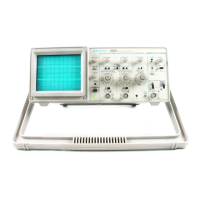Theory of Operation—2205 Service
Final amplification of the vertical signal is done by
the Vertical Output Amplifier. This stage produces
the signal levels that vertically deflect the crt elec
tron beam. For locating the position of off-screen
displays, the dynamic range of the Amplifier can be
limited with the Beam Find circuitry. This circuitry
also intensifies the trace and limits horizontal
deflection.
triggering
The Trigger circuitry uses either the Internal Trig
ger signal obtained from the input signal (s), an
External Trigger signal, or a Line Trigger signal
derived from the ac power source to develop trigger
signals for the Sweep Generator. The P-P Auto Trig
ger circuit sets the range of the Trigger Level to con
form to within the peak-to-peak amplitude of the
selected trigger signal when either P-P Auto or TV
Field Trigger mode is selected. This allows triggering
on most signals without needing to adjust the
TRIGGER LEVEL control. In NORM mode, the
TRIGGER LEVEL control must be adjusted to the
signal level before a sweep will be triggered.
The triggering circuitry contains the TV Field Sync
circuit. This circuit provides stable triggering on
television vertical-sync pulses when in the TV Field
triggering mode. TV Line triggering is possible using
P-P AUTO trigger mode.
Sweep
The Sweep Logic circuit controls the sweep
generation and Z-Axis unblanking for the Sweep dis
play. When the TRIGGER Mode switches are set to
either P-P AUTO or TV FIELD and no trigger signal is
present, the Auto Baseline circuit causes the Sweep
Logic circuit to produce a sweep for reference pur
poses. in the NORM setting, the Auto Baseline circuit
is disabled and sweeps are not generated until a
trigger event occurs. This is useful for triggering on
low-repetition rate signals. The SGL SWP (single
sweep) trigger mode allows only one sweep to be
generated after being reset. Following the single
sweep, the Trigger circuit is disabled until the SGL
SWP RESET button is pressed again.
The Sweep Logic circuit controls the operation of
the Miller Sweep Generator circuit. The Sweep
circuit produces a linear sweep with a ramp time that
is controlled by the SEC/DIV switch setting. The
sweep signal is applied to the Horizontal Preamplifier
for initial amplification and then to the Horizontal
Output Amplifier to drive the crt horizontal deflection
plates.
Horizontal
The Horizontal Preamplifier gain is increased by a
factor of to when the Horizontal MAG control is
used. Horizontal positioning of the display is done in
the Horizontal Preamplifier circuit.
In the X-Y mode of operation, the Channel 1 sig
nal from the internal Trigger circuitry passes through
the X-Y Amplifier to the Horizontal Preamplifier. In
this operating mode, the Channel 1 Internal Trigger
signal supplies the horizontal deflection to the crt,
and the Miller Sweep circuit is disabled to inhibit
sweep generation.
Z-Axis
The Z-Axis drive from the ;Swie|t)-'"ilogici circuit is
applied to the Z-Axis Amplifier. The output signal
from the Z-Axis Amplifier circuit sets the crt in
tensity. When using Chop Vertical mode, a bianking
signal from the Chop Oscillator circuit blanks the crt
display while switching between the vertical
channels.
The DC Restorer circuit applies the output voltage
of the Z-Axis Amplifier between the cathode and
grid of the crt. High dc potentials on these elements
prohibit direct coupling to the crt.
Power Supply
The Power Supply provides the necessary
operating voltages for the instrument. Operating
potentials are obtained from a circuit consisting of
the Power Transformer, power supply control
circuits, inverter, and inverter transformer. The
inverter transformer secondary windings provide
various ac-levels that are rectified and filtered to
produce the operating voltages for the instrument
Probe Adjust
A front-panel PROBE ADJUST output is provided
for use in adjusting probe compensation. The
voltage at the PROBE ADJUST connector is a
negative-going square wave that has a peak-to-
peak amplitude of about 500 mV with a repetition
rate about 1 kHz.
3-2

